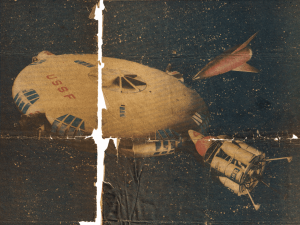A Trip to the Moon
In the earthbound world of 2006, he foresees flying arrowheads, elevators that move horizontally as well as vertically and cars that need no drivers. Fresco sees no reason not to expect an entire new electronic world within the next 50 years. “After all, we never expected to see atomic energy in our time” he suggests. He pictures an America of tomorrow connected by cross-country canals which will solve irrigation, flood control and transportation problems. His city of the future features National centers with buildings radiating out from the circular main structure. He envisions elevators that run underground from building to building, then up and down to various levels. Automobiles he sees as teardrop shapes topped with transparent plastic which automatically turns dark in the glare of sunlight. A photo-electric effect, similar to the negative process, makes possible the color change. Fresco’s cars would have proximity control, making collisions impossible, but the allowing the door to slide open and the seat to swing out to meet the driver when he approaches. A bottom worn by the motorist send out a signal which sets the door mechanics interaction, Fresco explains. Claiming already to have perfected an invention four wing de-icing, fresco expects the same principle to eliminate the need for windshield wipers. His theory is a probe which reaches out to measure the electrical charge in raindrop our snowflake and automatically sets the wing or windshield to take the…would be kept…never strike the object thus protected. Fresco pictures a turbo-jet helicopter which incorporates the plane body with the propeller blades for more speed. While the whole copter rotates, the pilot sits stationary in a central control chamber on wheels.
Fresco moved to Miami with his wife and three-year-old son about seven months ago, to escape Los Angeles smog. For the past seven years he had operated his scientific research laboratories in Los Angeles. It was there that he built his models of the world of tomorrow. He also worked as a movie technical adviser during the time. A Los Angeles concern now is perfecting his invention of stereoptician photographs, which do not require glasses, he says. Claiming a doctor’s degree in psychology from Sierra State University of Los Angeles, Fresco was a corporal with the Air Force design development division at Wright Field for 18 months, during World War II. He became interested in electronics while conducting psychological and physiological studies of vision and the working of the human mind, he says.

